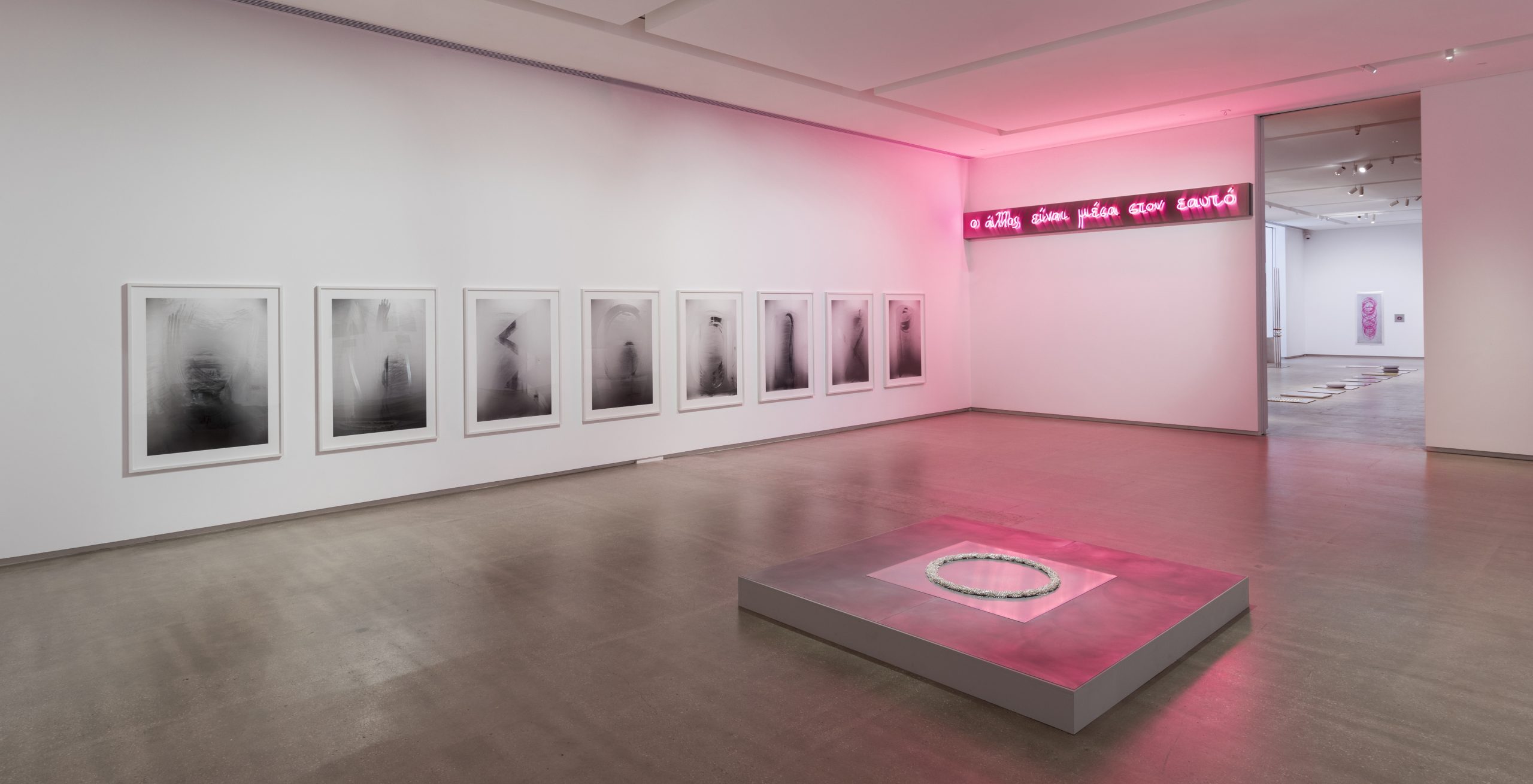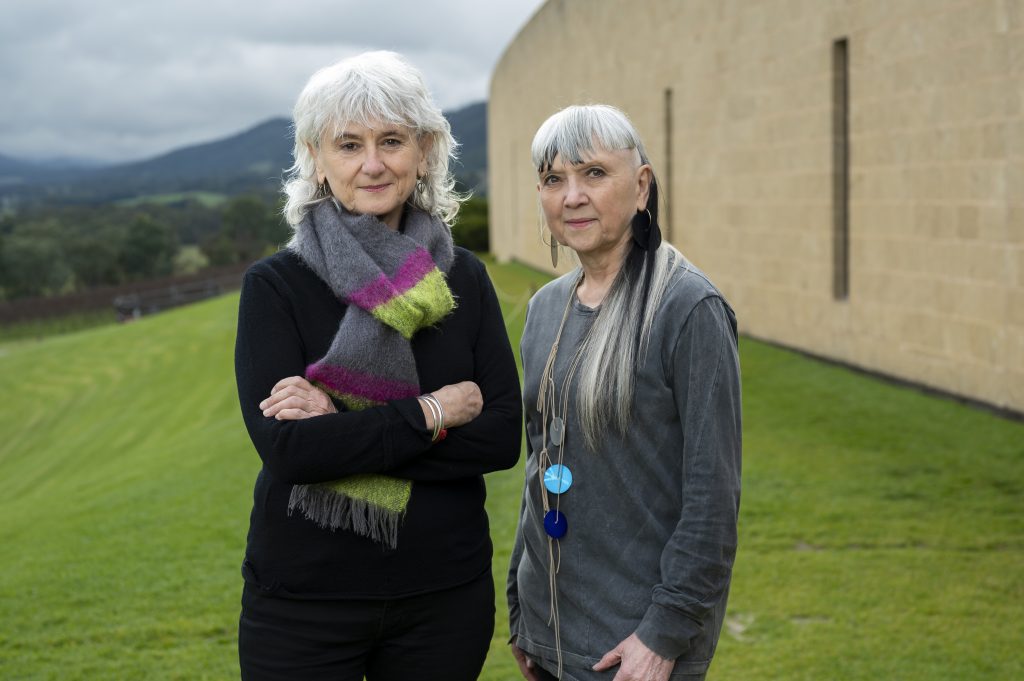The making of (SC)OOT(ER)ING around Su san Cohn and Eugenia Raskopoulos

Information for Students and Teachers.
Learn more about the exhibition (SC)OOT(ER)ING around as the TarraWarra Learning and Engagement team investigate the making of the exhibition with craft artist Su san Cohn, visual artist Eugenia Raskopoulos, and exhibition curator and Museum director, Dr Victoria Lynn.
- What is the title of this exhibition and how was it decided upon?
- As the curator, how did you work with the artists to create this exhibition?
- What ideas and themes are addressed in this exhibition?
- What will the audience see and experience in this exhibition?
- How were the artworks selected for this exhibition? What were some of the processes behind these decisions?
- How is the exhibition laid out? Did any of the artworks’ materials, size or installation needs influence their placement or inclusion in this exhibition?
- Is there something important you can share with students about your journey to becoming a professional artist?

Photo by T J Garvie at TarraWara Museum of Art
What is the title of this exhibition and how was it decided upon?
Victoria Lynn: The title (SC)OOT(ER)ING around was suggested by the artists. Written in capital letters, it includes the initials of each artist: SC and ER. This type of play on words is a common feature in both of their practices whereby they undermine existing conventions of the English language to assert a feminist perspective. In addition, it was important for each of us that the title include a verb, because the collaboration has been a process of scootering around one another, challenging each other, following different tangents, circling back around, travelling in parallel and, at times, trying to outwit each other. There are no straight lines or linear progressions in this exhibition: the ideas and propositions whirl around one another. The title is an invitation for the audience to ‘scoot around’ as well, making sense and connections between the works on display.
Su san Cohn: An excellent example of our three-way collaboration. We scootered around each other to get to (SC)OOT(ER)ING around
Eugenia Raskopoulos: The title was many conversations between all of us. Cohn & I wrote lists of words, and we discussed them, and I came up with (SC)OOT(ER)ING. In my titles I have used brackets and what I liked about (SC)OOT(ER)ING was that it had our initials in the word. We all then decided the title needed another word and it had to be a verb, something that was a ‘doing’ word. Also we all liked the idea of scootering around us and never being able to pin us down.
As the curator, how did you work with the artists to create this exhibition?
Victoria Lynn: This exhibition developed from a series of conversations, individually and collectively, that I have had with Su san Cohn and Eugenia Raskopoulos over two years. In 2022 I proposed an exhibition at TarraWarra Museum of Art and suggested that we develop it collaboratively. We did several joint sessions together talking about their work. They needed to get to know each other’s work in detail. We shared our ideas about themes: women’s rights, the body, the circle/hole, word play.
What ideas and themes are addressed in this exhibition?
Victoria Lynn: Themes addressed include:
- gender as a construct
- the rights of women
- freedom for the body: bodies have traditionally been classified according to a hierarchy throughout history – the artists and the exhibition advocate for the freedom of the body to be who or whatever it wants to be
- honouring significant women and their impact on society
- honouring life
- honouring death – in memoriam
- representations of the self – self portrait # 2 and then there is me
- language, words and wordplay as ways of showing that language and gender are constructs
Part of the impetus for (SC)OOT(ER)ING around was the fact that the #MeToo movement had dropped out of the headlines, and women’s rights and the rights of diverse bodies had moved off the front page. In the last decade or more, many of the rights that feminist and LGBTQIA+ artists, writers and thinkers have fought for have been dispelled, with the manifestation of what Judith Butler terms the ‘anti-gender’ movement. Her volume Who’s Afraid of Gender? suggests that the rights of individuals are being wound back in what she describes as a phantasm of anti-gender ideology.1 Political leaders who rail against the rights of diverse and non-binary genders tend to also rail against the threat of migrants. As Butler shows, the anti-gender movement is cast in a ‘syntactical bundle’2 that includes the freedoms of women, trans people, LGBTQIA+ people, migrants and refugees who are seen as a threat to national security.
Olivia Laing concludes her book with hope: ‘Freedom does not mean being unburdened by the past … a free body need not be whole or undamaged or unaugmented. It is always changing, changing, changing, a fluid form after all.’3
What will the audience see and experience in this exhibition?
Victoria Lynn: empowerment, misbehaviour, challenge, beauty, love, life, death, leading women, multiple interpretations of the self
Eugenia Raskopoulos: questioning the role of women in society, trying to break the norm, looking at language and how it can affect people, sitting in the position of the other; the other for me is in two parts: one, being a woman and secondly, not being of Anglo background.
Su san Cohn: a celebration of women; a play with the power of our voices; questioning about what jewellery is and can be; two different artists’ way of working on the same idea, using photography, neon, video and craft making;.
How were the artworks selected for this exhibition? What were some of the processes behind these decisions?
Victoria Lynn: I asked the artists to choose three works from an earlier period that they thought absolutely HAD to be in the show. We discussed options and came up with the list. The Museum then had to write to the owners of the works to borrow them: National Gallery of Australia, National Gallery of Victoria and Art Gallery of NSW.
The second stage was to develop new work for the exhibition. Raskopoulos was already working on and the beat goes on… and so we decided it would be a major work in the exhibition. The neon circle I am a girl with a long tongue is the second in a new self-portrait series. slutter was made to go alongside stutter. Cohn’s series I wish I was more like HER is partly in response to Eugenia’s work and the beat goes on…, but also part of a long-term interest in leading female cultural figures. Step by step (how to get there) was based on a Leunig cartoon in her studio. Then there is me was a response to I wish I was more like HER and acknowledges the women who have nurtured her career.
The third stage was the development of works in collaboration. There are three collaborative works: word of mouth, you’re too sharp!, swapping me for you.
How is the exhibition laid out? Did any of the artworks’ materials, size or installation needs influence their placement or inclusion in this exhibition?
Victoria Lynn: Most of the early works are in the first room (South Gallery) as an introduction to their work.
The artists’ works are co-mingled in space.
The sides of the gallery that they are displayed on is not consistent, ie it is not Raskopoulos on one side and Cohn on the other.
The size of and the beat goes on… meant that it had to be in the Main gallery. The fact that it is red neon led to the decision to paint the wall in ‘ageless grey’. The reason is that it is more dramatic, contained, and the glow of the neon is limited to the grey zone rather than the whole space.
As one of the artists represented in and the beat goes on… passed away we needed to find a place for the bronze, which meant that we put the work raskographs in its own space and moved the videos to the vista.
The North Gallery was zoned for the new collaborative work, which is made site-specific to that space.
The semi-permanent wall in the South Gallery was moved into the Main gallery to open up the South Gallery and allow diglossia # 1–8 to be shown in full.
The changes that happen in floorplans are quite common and can be achieved in small to medium museums where we are more nimble. This could not happen at the NGV for example.
The artists visited the site several times to discuss the layout.
Is there something important you can share with students about your journey to becoming a professional artist?
Eugenia Raskopoulos: For me the journey started at high school. I chose art in years 11 & 12. I loved art but I wasn’t great at drawing so felt I couldn’t do art. I gave it a go in my senior years and had the most amazing teacher who changed my life. Her encouragement was extraordinary! After high school I went straight to art school at Sydney College of the Arts. I was in the first intake of Sydney College of the Arts; it was an extraordinary experience that opened my mind in many ways. The rest is history. It is not an easy path but an extremely rewarding path.
Su san Cohn: There is always a way. You may not know it, but if you keep trying different things, you will find it.
For me, the journey started with a grandmother who took me to art galleries every school holiday. It piqued my curiosity about how and why artists made work. We didn’t have art as a subject at school, so I borrowed books from the library to read about art and artists. I couldn’t attend art school after high school, so I did an apprenticeship with a graphic designer. My mentor introduced me to contemporary art, took me to exhibitions and constantly gave me books to read about art movements, history, and artists. But I wasn’t very good at graphics. I became obsessed with discovering my way of making art. I nagged my friends about what to do. Finally, in my mid-twenties, following one suggestion, I studied gold and silversmithing at RMIT and was lucky enough to find what I love to do.
*****
Are you a teacher or educator? Join our Learning & Engagement mailing list to get occasional updates from our team about school tours, education resources, personal development sessions and other education updates.